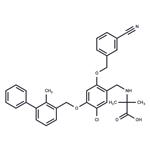| Company Name: |
InvivoChem Gold
|
| Tel: |
13549236410 |
| Email: |
sales@invivochem.cn |
| Products Intro: |
Product Name:NP19
CAS:2377916-66-8
Purity:98% HPLC Package:1mg Remarks:V37662
|
| Company Name: |
ChemCell Biomedicine Co.,Ltd.
|
| Tel: |
020-13556033878 2965585218 13556033878 |
| Email: |
chemcell@hotmail.com |
| Products Intro: |
Product Name:PD-1/PD-L1-IN-NP19
CAS:2377916-66-8
Purity:98% Package:5mg;10mg;20mg;50mg;100mg;250mg;500mg;1g;5g;10g;25g;100g
|
Alanine, N-[[5-chloro-2-[(3-cyanophenyl)methoxy]-4-[(2-methyl[1,1'-biphenyl]-3-yl)methoxy]phenyl]methyl]-2-methyl- manufacturers
- PD-1/PD-L1-IN-NP19
-

- $376.00 / 5mg
-
2025-10-27
- CAS:2377916-66-8
- Min. Order:
- Purity:
- Supply Ability: 10g
|
| | Alanine, N-[[5-chloro-2-[(3-cyanophenyl)methoxy]-4-[(2-methyl[1,1'-biphenyl]-3-yl)methoxy]phenyl]methyl]-2-methyl- Basic information |
| | Alanine, N-[[5-chloro-2-[(3-cyanophenyl)methoxy]-4-[(2-methyl[1,1'-biphenyl]-3-yl)methoxy]phenyl]methyl]-2-methyl- Chemical Properties |
| Boiling point | 715.5±60.0 °C(Predicted) | | density | 1.28±0.1 g/cm3(Predicted) | | storage temp. | Store at -20°C | | solubility | DMSO : 6.25 mg/mL (11.26 mM; Need ultrasonic) | | form | A crystalline solid | | pka | 2.03±0.10(Predicted) | | color | White to off-white | | InChIKey | YZPKZNFXWGTUGO-UHFFFAOYSA-N | | SMILES | C(O)(=O)[C@](C)(C)NCC1=CC(Cl)=C(OCC2C=CC=C(C3=CC=CC=C3)C=2C)C=C1OCC1=CC=CC(C#N)=C1 |
| | Alanine, N-[[5-chloro-2-[(3-cyanophenyl)methoxy]-4-[(2-methyl[1,1'-biphenyl]-3-yl)methoxy]phenyl]methyl]-2-methyl- Usage And Synthesis |
| Uses | PD-1/PD-L1-IN-NP19 is a PD-1/PD-L1 inhibitor, with an IC50 of 12.5 nM for human PD-1/PD-L1 interaction. PD-1/PD-L1-IN-NP19 could activate the immune microenvironment in tumor, which may contribute to its antitumor effects[1]. | | Biological Activity | PD-1/PD-L1-IN-NP19 is a PD-1/PD-L1 inhibitor, with an IC50 of 12.5 nM for human PD-1/PD-L1 interaction. PD-1/PD-L1-IN-NP19 could activate the immune microenvironment in tumor, which may contribute to its antitumor effects[1].
PD-1/PD-L1-IN-NP19 (compound NP19) (0.37-10 μM; 72 h) significantly elevates the production of IFN-γ in a dose dependent manner from T cells co-cultured with tumor cells[1].PD-1/PD-L1-IN-NP19 exhibits much lower activity for inhibiting mouse PD-1/PD-L1 interaction with an IC50 in the micromolar range (>1μM), as compared to the inhibition of human PD1/PD-L1 interaction (IC50=12.5 nM)[1].PD-1/PD-L1-IN-NP19 (10 μM; 48 h) displays no apparent cytotoxic effects on A549, MCF-7, and B16-F10 cells at a concentration of 10 μM[1].
PD-1/PD-L1-IN-NP19 (compound NP19) (25-100 mg/kg; intragastric gavage once daily for 15 d) inhibits the growth of melanoma tumors dramatically in mice[1].PD-1/PD-L1-IN-NP19 (25 mg/kg; i.p. daily for 14 d) demonstrates significant antitumor efficacy with a tumor growth inhibition (TGI) of 76.5% and is well tolerated in an H22 hepatoma mouse model[1].PD-1/PD-L1-IN-NP19 (1 mg/kg; i.v.) shows the half time (t1/2=1.5±0.5 h), clearance rate (CL=0.9±0.2 L/h/kg) and apparent distribution volume (Vss=2.1±0.5 L/kg) in rats[1].PD-1/PD-L1-IN-NP19 (10 mg/kg; p.o.) shows the oral absorption (Tmax=0.6±0.2 h), long half-life (t1/2=10.9±7.7 h) and oral bioavailability (F=5%) in rats[1]. | | in vivo | PD-1/PD-L1-IN-NP19 (compound NP19) (25-100 mg/kg; intragastric gavage once daily for 15 d) inhibits the growth of melanoma tumors dramatically in mice[1].
PD-1/PD-L1-IN-NP19 (25 mg/kg; i.p. daily for 14 d) demonstrates significant antitumor efficacy with a tumor growth inhibition (TGI) of 76.5% and is well tolerated in an H22 hepatoma mouse model[1].
PD-1/PD-L1-IN-NP19 (1 mg/kg; i.v.) shows the half time (t1/2=1.5±0.5 h), clearance rate (CL=0.9±0.2 L/h/kg) and apparent distribution volume (Vss=2.1±0.5 L/kg) in rats[1].
PD-1/PD-L1-IN-NP19 (10 mg/kg; p.o.) shows the oral absorption (Tmax=0.6±0.2 h), long half-life (t1/2=10.9±7.7 h) and oral bioavailability (F=5%) in rats[1].
| Animal Model: | BALB/c mice (6-8 weeks) with B16-F10 melanoma tumors[1] | | Dosage: | 25, 50, 100 mg/kg | | Administration: | Intragastric gavage once daily for 15 days | | Result: | Inhibited the growth of melanoma tumors up to 51.1, 75 and 80.9% at dose of 25, 50, 100 mg/kg, respectively.
Exhibited normal physical activity and increased body weights slightly.
|
| Animal Model: | Male Sprague-Dawley rats[1] | | Dosage: | 1 mg/kg for i.v. and 10 mg/kg for p.o. (Pharmacokinetic Analysis) | | Administration: | I.v. and p.o. | | Result: | I.v.: t1/2=1.5 h; Cmax=1751 μg/L; CL=0.9 L/h/kg.
P.o.: t1/2=10.9 h; Cmax=69.5 μg/L; CL=23.1 L/h/kg.
|
| | References | [1]. Cheng B, et, al. Discovery of Novel Resorcinol Dibenzyl Ethers Targeting the Programmed Cell Death-1/Programmed Cell Death-Ligand 1 Interaction As Potential Anticancer Agents. J Med Chem. 2020 Jul 15. |
| | Alanine, N-[[5-chloro-2-[(3-cyanophenyl)methoxy]-4-[(2-methyl[1,1'-biphenyl]-3-yl)methoxy]phenyl]methyl]-2-methyl- Preparation Products And Raw materials |
|